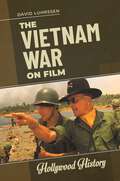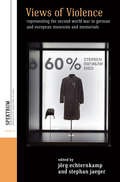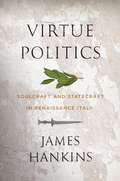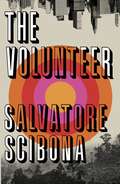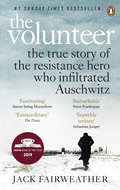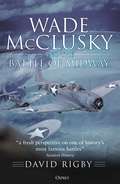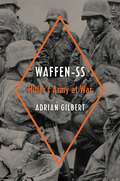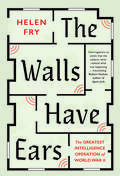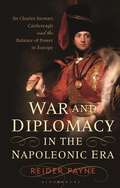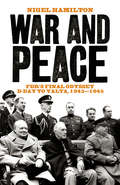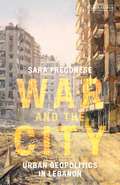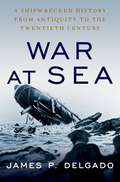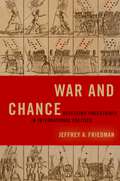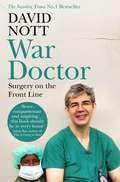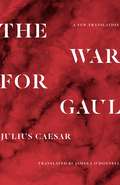- Table View
- List View
The Vietnam War on Film (Hollywood History)
by David LuhrssenVietnam War on Film illustrates how to employ film as a teaching tool. It also stands on its own as an account of the war and the major films that have depicted it.Even for many people who experienced the Vietnam War first hand, memories of that conflict have often been shaped by the popular films that depicted it: The Quiet American, The Green Berets, The Deer Hunter, Coming Home, Platoon, Full Metal Jacket, and Apocalypse Now, among others. Vietnam War on Film examines how the war is portrayed through a selection of ten iconic films that represent the war through dramatization and storytelling as opposed to through documentary footage. The book includes an introduction to the war's history and a timeline of events, followed by ten chapters, each of which focuses on a specific Vietnam War movie. Chapters offer a uniquely detailed level of historical context for the films, weighing their depiction of events against the historical record and evaluating how well or how poorly those films reflected the truth and shaped public memory and discourse over the war. A final section of "Resources" provides a comprehensive annotated bibliography of print and electronic sources to aid students and teachers in further research.
The Vietnam War on Film (Hollywood History)
by David LuhrssenVietnam War on Film illustrates how to employ film as a teaching tool. It also stands on its own as an account of the war and the major films that have depicted it.Even for many people who experienced the Vietnam War first hand, memories of that conflict have often been shaped by the popular films that depicted it: The Quiet American, The Green Berets, The Deer Hunter, Coming Home, Platoon, Full Metal Jacket, and Apocalypse Now, among others. Vietnam War on Film examines how the war is portrayed through a selection of ten iconic films that represent the war through dramatization and storytelling as opposed to through documentary footage. The book includes an introduction to the war's history and a timeline of events, followed by ten chapters, each of which focuses on a specific Vietnam War movie. Chapters offer a uniquely detailed level of historical context for the films, weighing their depiction of events against the historical record and evaluating how well or how poorly those films reflected the truth and shaped public memory and discourse over the war. A final section of "Resources" provides a comprehensive annotated bibliography of print and electronic sources to aid students and teachers in further research.
Views of Violence: Representing the Second World War in German and European Museums and Memorials (Spektrum: Publications of the German Studies Association #19)
by Jörg Echternkamp and Stephan JaegerTwenty-first-century views of historical violence have been immeasurably influenced by cultural representations of the Second World War. Within Europe, one of the key sites for such representation has been the vast array of museums and memorials that reflect contemporary ideas of war, the roles of soldiers and civilians, and the self-perception of those who remember. This volume takes a historical perspective on museums covering the Second World War and explores how these institutions came to define political contexts and cultures of public memory in Germany, across Europe, and throughout the world.
Virgin River (A Virgin River Novel #1)
by Robyn CarrAn Original Netflix Series – Out Now! Read the book that started it all! 13 Million Copies Sold Sometimes all you need is a fresh start
Virtue Politics: Soulcraft and Statecraft in Renaissance Italy
by James HankinsJames Hankins challenges the view that the Renaissance was the seedbed of modern republicanism, with Machiavelli as exemplary thinker. What most concerned Renaissance political theorists, Hankins contends, was not reforming laws but shaping citizens. To secure the social good, they fostered virtue through a new program of education: the humanities.
Visions and Ideas of Europe during the First World War (Ideas beyond Borders)
by Jan Vermeiren Matthew D'AuriaGiven the destruction and suffering caused by more than four years of industrialised warfare and economic hardship, scholars have tended to focus on the nationalism and hatred in the belligerent countries, holding that it led to a fundamental rupture of any sense of European commonality and unity. It is the central aim of this volume to correct this view and to highlight that many observers saw the conflict as a ‘European civil war’, and to discuss what this meant for discourses about Europe. Bringing together a remarkable range of compelling and highly original topics, this collection explores notions, images, and ideas of Europe in the midst of catastrophe.
Visions and Ideas of Europe during the First World War (Ideas beyond Borders)
by Jan Vermeiren Matthew D'AuriaGiven the destruction and suffering caused by more than four years of industrialised warfare and economic hardship, scholars have tended to focus on the nationalism and hatred in the belligerent countries, holding that it led to a fundamental rupture of any sense of European commonality and unity. It is the central aim of this volume to correct this view and to highlight that many observers saw the conflict as a ‘European civil war’, and to discuss what this meant for discourses about Europe. Bringing together a remarkable range of compelling and highly original topics, this collection explores notions, images, and ideas of Europe in the midst of catastrophe.
Voices of Scotswomen in Peace and War: Spoken Recollections of Home Life, Employment and 1939-45 War Service
by Ian MacDougallDuring the Second World War thousands of women served with the Auxiliary Territorial Service (ATS), the Women’s Auxiliary Air Force (WAAF), Women’s Royal Naval Service (WRNS) or the Timber Corps. In this book 19 Scotswomen who served in the war tell their stories. The women, born between 1918 and 1926, and interviewed between 1998 and 2005, came from towns and villages throughout Scotland.The 1939–45 War plucked many women from their normal lives and thrust them into very different and dangerous experiences. Leaving her job in a baker’s shop in Glasgow, one woman found herself early in 1945 on a troopship heading for Naples; another, as an officer in the WRNS, crossed the Atlantic three times. One woman escaped death when 26 of her ATS colleagues were killed at Yarmouth by a German bomber. Despite the danger, many women formed close and lasting friendships, and for some the war years were the happiest of their lives. These fascinating stories of wartime women, told in their own words, vividly convey the important and varied roles that women played during the war.
The Volunteer: A Novel
by Salvatore ScibonaAn odyssey of loss and salvation ranging across four generations of fathers and sons, in the finest tradition of American storytelling.The year is 1966 and a young man named Vollie Frade, almost on a whim, enlists in the United States Marine Corps to fight in Vietnam. Breaking definitively from his rural Iowan parents, Vollie puts in motion a chain of events that sees him go to work for people with intentions he cannot yet grasp. From the Cambodian jungle, to a flophouse in Queens, to a commune in New Mexico, Vollie's path traces a secret history of life on the margins of America, culminating with an inevitable and terrible reckoning.Scibona’s story of a restless soldier pressed into service for a clandestine branch of the US government unfolds against the backdrop of the seismic shifts in global politics of the second half of the twentieth century. Epic in scope but intimate in feeling, this is a deeply immersive read from a rising star of American fiction.
The Volunteer: The True Story of the Resistance Hero who Infiltrated Auschwitz
by Jack FairweatherTotally gripping … fascinating, revelatory and surreal -- Simon Sebag MontefioreHow do you keep fighting in the face of unimaginable horror?This is untold story of one of the greatest heroes of the Second World War.In the Summer of 1940, after the Nazi occupation of Poland, an underground operative called Witold Pilecki accepted a mission to uncover the fate of thousands of people being interred at a new concentration camp on the border of the Reich. His mission was to report on Nazi crimes and raise a secret army to stage an uprising. The name of the detention centre -- Auschwitz.It was only after arriving at the camp that he started to discover the Nazi’s terrifying designs. Over the next two and half years, Witold forged an underground army that smuggled evidence of Nazi atrocities out of Auschwitz. His reports from the camp were to shape the Allies response to the Holocaust - yet his story was all but forgotten for decades. This is the first major account of his amazing journey, drawing on exclusive family papers and recently declassified files as well as unpublished accounts from the camp’s fighters to show how he saved hundreds of thousands of lives.The result is a enthralling story of resistance and heroism against the most horrific circumstances, and one man’s attempt to change the course of history.
Vom Kriege: Hinterlassenes Werk Des Generals Carl Von Clausewitz (The World At War)
by Carl ClausewitzDie Formel, der Krieg sei die Fortsetzung der Politik mit anderen oder zusätzlichen Mitteln, führt weiter als die banalen Bemerkungen über die Verbindung von Politik und Krieg. Clausewitz entwickelt die Idee in zwei Richtungen: Die Führung des Krieges liegt bei der politischen Macht und nicht bei den Führern der Armee.
Wade McClusky and the Battle of Midway
by David RigbyDuring the Battle of Midway in June 1942, US Navy dive bomber pilot Wade McClusky proved himself to be one of the greatest pilots and combat leaders in American history, but his story has never been told – until now. It was Wade McClusky who remained calm when the Japanese fleet was not where it was expected to be. It was he who made the counterintuitive choice to then search to the north instead of to the south. It was also McClusky who took the calculated risk of continuing to search even though his bombers were low on fuel and may not have enough to make it back to the Enterprise. His ability to remain calm under enormous pressure played a huge role in the US Navy winning this decisive victory that turned the tide of war in the Pacific. This book is the story of exactly the right man being in exactly the right place at exactly the right time. Wade McClusky was that man and this is his story.
Waffen-SS: Hitler's Army at War
by Adrian GilbertFrom an award-winning and bestselling historian, the first comprehensive military history in over fifty years of Hitler's famous and infamous personal army: the Waffen-SS.The Waffen-SS was one of the most feared combat organizations of the twentieth century. Originally formed as a protection squad for Adolf Hitler it became the military wing of Heinrich Himmler's SS and a key part of the Nazi state, with nearly 900,000 men passing through its ranks. The Waffen-SS played a crucial role in furthering the aims of the Third Reich which made its soldiers Hitler's political operatives. During its short history, the elite military divisions of the Waffen-SS acquired a reputation for excellence, but their famous battlefield record of success was matched by their repeated and infamous atrocities against both soldiers and civilians.Waffen-SS is the first definitive single-volume military history of the Waffen-SS in more than fifty years. In considering the actions of its leading personalities, including Himmler, Sepp Dietrich, and Otto Skorzeny, and analyzing its specialist training and ideological outlook, eminent historian Adrian Gilbert chronicles the battles and campaigns that brought the Waffen-SS both fame and infamy.
Waiting for War: Britain 1939–1940
by Barry TurnerAt the outbreak of war in 1939, ordinary people were quickly forced to adapt to the realities of a nation under dire threat. But it soon became known as the Phoney War, a time when official incompetence reigned supreme. Theatres and cinemas were closed and football matches cancelled, only for the government to realise belatedly that morale was plunging as a result. Thousands of women and children were evacuated to the countryside, only for many to flood back to the cities, preferring the dangers to separation from their families. Censorship of news was heavy-handed and bred widespread resentment. In fact, the period from September 1939 to May 1940 was a time of intense political and military activity – the blitzkrieg on Poland, the start of the U-boat menace, the disastrous Norwegian campaign, the political manoeuvrings that brought Churchill to power. Barry Turner skilfully weaves these events into a compelling home front narrative which evokes the fears and dangers but also the humour and the absurdities of everyday life in the dark days of 1939–1940.
Walker Bulldog vs T-54: Laos and Vietnam 1971–75 (Duel #94)
by Chris McNabDuring the Vietnam War, both the United States and the Soviet Union supplied all manner of weapon systems to the opposing sides, including tanks and armoured vehicles. Two tanks in particular took momentary prominence in the later years of the conflict. On the South Vietnamese side, it was the US M41 Walker Bulldog; for the communist North Vietnamese, the Soviet-supplied T-54 main battle tank was the core of their armoured power. In their first major engagement, during Operation Lam Son 719 (February–March 1971), it was the Walker Bulldog in the ascendant, but in later battles the T-54s inflicted heavy losses on their lighter opponents, taking the advantage through their superior manoeuvrability and gunnery. Illustrated with full-colour artwork as well as rare and revealing photographs from both sides, this book studies these two iconic tanks in Vietnamese service, examining how their differing designs and fighting doctrines affected their performance in this unique theatre of combat.
The Walls Have Ears: The Greatest Intelligence Operation of World War II
by Helen FryA history of the elaborate and brilliantly sustained World War II intelligence operation by which Hitler’s generals were tricked into giving away vital Nazi secrets At the outbreak of World War II, MI6 spymaster Thomas Kendrick arrived at the Tower of London to set up a top secret operation: German prisoners’ cells were to be bugged and listeners installed behind the walls to record and transcribe their private conversations. This mission proved so effective that it would go on to be set up at three further sites—and provide the Allies with crucial insight into new technology being developed by the Nazis. In this astonishing history, Helen Fry uncovers the inner workings of the bugging operation. On arrival at stately-homes-turned-prisons like Trent Park, high-ranking German generals and commanders were given a "phony" interrogation, then treated as "guests," wined and dined at exclusive clubs, and encouraged to talk. And so it was that the Allies got access to some of Hitler’s most closely guarded secrets—and from those most entrusted to protect them.
War and Diplomacy in the Napoleonic Era: Sir Charles Stewart, Castlereagh and the Balance of Power in Europe
by Reider PayneThe lives and careers of Sir Charles Stewart and his brother Lord Castlereagh take in a grand stage, from Britain and Ireland to the kingdoms and empires of western and central Europe. Throughout his life Stewart played a key role in shaping Europe: his is a Regency drama beyond anything imagined by Jane Austen: warfare, diplomacy, affairs, royal scandal, a romantic and brilliant marriage, and a brother's suicide. Stewart was at the heart of some of history's greatest events which took him from the bloodiest actions of the Napoleonic Wars to the palaces of Europe's ruling dynasties. For an all too brief period, Stewart blazed across the battlefields and chancelleries of Europe, enjoying a meteoric rise to the highest positions and influence, in a career indelibly linked to his brother's and one which is virtually unique. Stewart even found time to enjoy his share of scandal, from affairs and parties in Vienna to running a spy network which aimed to charge a Princess of Wales with adultery. Reider Payne's book is international in its scope and ambitions: with Stewart's military and diplomatic theatre of operations including Portugal, Spain, Prussia, Saxony, France, Austria and the Austrian territories in Italy. Stewart sat at the heart of the intrigues and social circles of Regency England, and his life story offers an unrivalled viewpoint into the competing claims and demands of Europe's courts.
War and Peace: FDR's Final Odyssey D-Day to Yalta, 1943-1945 (Fdr At War Ser. #3)
by Nigel HamiltonIn the much-anticipated conclusion to his masterful trilogy chronicling the wartime career of Franklin Delano Roosevelt, renowned military and political biographer Nigel Hamilton aligns triumph with tragedy to show how FDR was the architect of a victorious peace that he would not live to witness. Providing the definitive account of the events in Normandy on 6 June 1944, Hamilton also reveals the fraught nature of the relationship between the greatest wartime leaders of the Allied forces.Using hitherto unpublished documents and interviews to counter the famous narrative of World War II strategy given by Winston Churchill in his memoirs, Hamilton highlights the true significance of FDR’s leadership. Seventy-five years after the D-Day landings, we finally see, close up and in dramatic detail, who was responsible for rescuing – and insisting upon – the great American-led invasion of France in June 1944, and exactly why that invasion was orchestrated by Eisenhower.War and Peace is the rousing final installment in one of the most important historical biographies of the twenty-first century, which demonstrates how FDR’s failing health only spurred him on in his efforts to build a US-backed post-war world order. In this stirring account of the life of one of the most celebrated political leaders of our time, Hamilton hails the President as the sole person capable of anticipating the requirements of peace in order to bring an end to the war.
War at Sea: A Shipwrecked History from Antiquity to the Twentieth Century
by James P. DelgadoThe ocean is humanity's largest battlefield. Resting in its depths lie the lost ships of war, spanning the totality of human history. Many wrecks are nameless, others from more recent times are remembered, honored even, as are the battles that claimed them, like Actium, Trafalgar, Tsushima, Jutland, Pearl Harbor, and Midway. Underwater exploration is increasingly discovering long-lost warships from the deepest parts of the ocean, revealing a vast undersea museum that speaks to battles won and lost, service, sacrifice, and the human costs of warfare. War at Sea is a dramatic global tour of this remote museum and other formerly lost traces of humanity's naval heritage. It is also an account by the world's leading naval archaeologist of how underwater exploration has discovered these remains, thus resolving mysteries, adding to our understanding of the past, and providing intimate details of the experience of naval warfare. Arranged chronologically, the book begins with the warships and battles of the ancient Egyptians, Phoenicians, Greeks, Romans, and Chinese, and then progresses through three thousand years to the lost ships of the Cold War. James Delgado, who has personally explored, dived, and studied a number of the wrecks and sites in the book, provides insights as an explorer, archaeologist, and storyteller. The result is a unique and compelling history of naval warfare. From fallen triremes and galleons to dreadnoughts, aircraft carriers, and nuclear submarines, this book vividly brings thousands of years of naval warfare to life.
War Bows: Longbow, crossbow, composite bow and Japanese yumi
by Mike LoadesWar bows dominated battlefields across the world for centuries. In their various forms, they allowed trained archers to take down even well-armoured targets from great distances, and played a key role in some of the most famous battles in human history. The composite bow was a versatile and devastatingly effective weapon, on foot, from chariots and on horseback for over a thousand years, used by cultures as diverse as the Hittites, the Romans, the Mongols and the Ottoman Turks. The Middle Ages saw a clash between the iconic longbow and the more technologically sophisticated crossbow, most famously during the Hundred Years War, while in Japan, the samurai used the yumi to deadly effect, unleashing bursts of arrows from their galloping steeds. Historical weapons expert Mike Loades reveals the full history of these four iconic weapons that changed the nature of warfare. Complete with modern ballistics testing, action recreations of what it is like to fire each bow and a critical analysis of the technology and tactics associated with each bow, this book is a must-have for anyone interested in ancient arms.
WAR & CHANCE BTG C: Assessing Uncertainty in International Politics (Bridging the Gap)
by Jeffrey A. FriedmanUncertainty surrounds every major decision in international politics. Yet there is almost always room for reasonable people to disagree about what that uncertainty entails. No one can reliably predict the outbreak of armed conflict, forecast economic recessions, anticipate terrorist attacks, or estimate the countless other risks that shape foreign policy choices. Many scholars and practitioners therefore believe that it is better to keep foreign policy debates focused on the facts - that it is, at best, a waste of time to debate uncertain judgments that will often prove to be wrong. In War and Chance, Jeffrey A. Friedman shows how foreign policy officials often try to avoid the challenge of assessing uncertainty, and argues that this behavior undermines high-stakes decision making. Drawing on an innovative combination of historical and experimental evidence, he explains how foreign policy analysts can assess uncertainty in a manner that is theoretically coherent, empirically meaningful, politically defensible, practically useful, and sometimes logically necessary for making sound choices. Each of these claims contradicts widespread skepticism about the value of probabilistic reasoning in international politics, and shows how placing greater emphasis on assessing uncertainty can improve nearly any foreign policy debate. A clear-eyed examination of the logic, psychology, and politics of assessing uncertainty, War and Chance provides scholars and practitioners with new foundations for understanding one of the most controversial elements of foreign policy discourse.
War Doctor: Surgery on the Front Line
by David Nott‘Brave, compassionate and inspiring – it left me in floods of tears’ Adam Kay, author of This Is Going to Hurt For more than twenty-five years, David Nott has taken unpaid leave from his job as a general and vascular surgeon with the NHS to volunteer in some of the world’s most dangerous war zones. From Sarajevo under siege in 1993, to clandestine hospitals in rebel-held eastern Aleppo, he has carried out life-saving operations and field surgery in the most challenging conditions, and with none of the resources of a major London teaching hospital. The conflicts he has worked in form a chronology of twenty-first-century combat: Afghanistan, Sierra Leone, Liberia, Darfur, Congo, Iraq, Yemen, Libya, Gaza and Syria. But he has also volunteered in areas blighted by natural disasters, such as the earthquakes in Haiti and Nepal. Driven both by compassion and passion, the desire to help others and the thrill of extreme personal danger, he is now widely acknowledged to be the most experienced trauma surgeon in the world. But as time went on, David Nott began to realize that flying into a catastrophe – whether war or natural disaster – was not enough. Doctors on the ground needed to learn how to treat the appalling injuries that war inflicts upon its victims. Since 2015, the foundation he set up with his wife, Elly, has disseminated the knowledge he has gained, training other doctors in the art of saving lives threatened by bombs and bullets. War Doctor is his extraordinary story.
The War for Gaul: A New Translation
by Julius CaesarA new translation that captures the gripping power of one of the greatest war stories ever told—Julius Caesar’s pitiless account of his brutal campaign to conquer GaulImagine a book about an unnecessary war written by the ruthless general of an occupying army—a vivid and dramatic propaganda piece that forces the reader to identify with the conquerors and that is designed, like the war itself, to fuel the limitless political ambitions of the author. Could such a campaign autobiography ever be a great work of literature—perhaps even one of the greatest? It would be easy to think not, but such a book exists—and it helped transform Julius Caesar from a politician on the make into the Caesar of legend. This remarkable new translation of Caesar’s famous but underappreciated War for Gaul captures, like never before in English, the gripping and powerfully concise style of the future emperor’s dispatches from the front lines in what are today France, Belgium, Germany, and Switzerland.While letting Caesar tell his battle stories in his own way, distinguished classicist James O’Donnell also fills in the rest of the story in a substantial introduction and notes that together explain why Gaul is the “best bad man’s book ever written”—a great book in which a genuinely bad person offers a bald-faced, amoral description of just how bad he has been.Complete with a chronology, a map of Gaul, suggestions for further reading, and an index, this feature-rich edition captures the forceful austerity of a troubling yet magnificent classic—a book that, as O’Donnell says, “gets war exactly right and morals exactly wrong.”
The War for Gaul: A New Translation
by Julius CaesarA new translation that captures the gripping power of one of the greatest war stories ever told—Julius Caesar’s pitiless account of his brutal campaign to conquer GaulImagine a book about an unnecessary war written by the ruthless general of an occupying army—a vivid and dramatic propaganda piece that forces the reader to identify with the conquerors and that is designed, like the war itself, to fuel the limitless political ambitions of the author. Could such a campaign autobiography ever be a great work of literature—perhaps even one of the greatest? It would be easy to think not, but such a book exists—and it helped transform Julius Caesar from a politician on the make into the Caesar of legend. This remarkable new translation of Caesar’s famous but underappreciated War for Gaul captures, like never before in English, the gripping and powerfully concise style of the future emperor’s dispatches from the front lines in what are today France, Belgium, Germany, and Switzerland.While letting Caesar tell his battle stories in his own way, distinguished classicist James O’Donnell also fills in the rest of the story in a substantial introduction and notes that together explain why Gaul is the “best bad man’s book ever written”—a great book in which a genuinely bad person offers a bald-faced, amoral description of just how bad he has been.Complete with a chronology, a map of Gaul, suggestions for further reading, and an index, this feature-rich edition captures the forceful austerity of a troubling yet magnificent classic—a book that, as O’Donnell says, “gets war exactly right and morals exactly wrong.”

